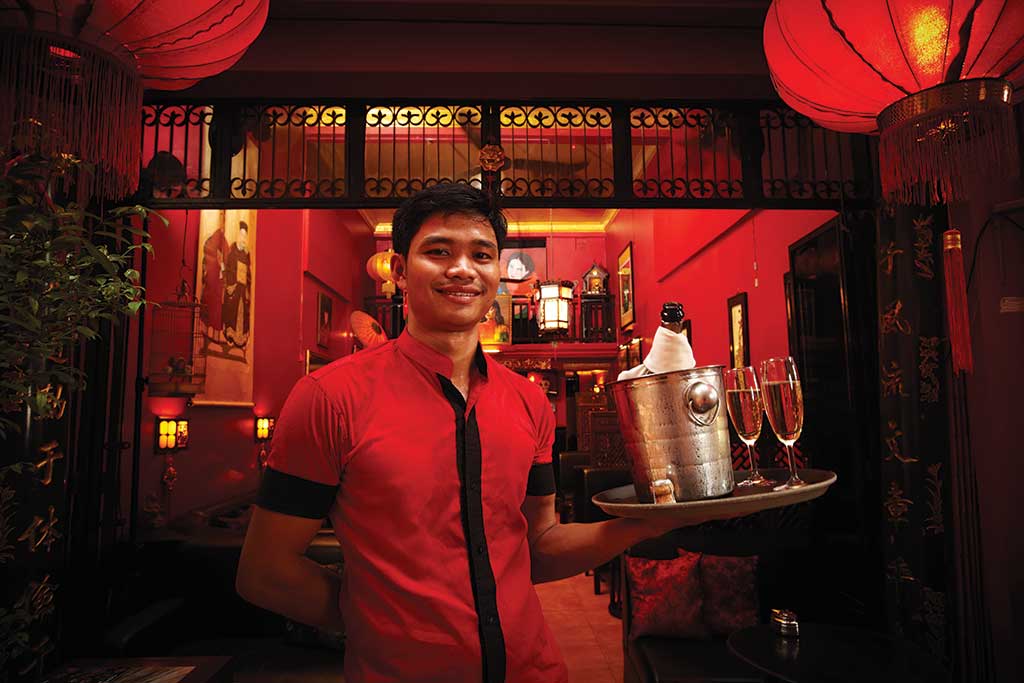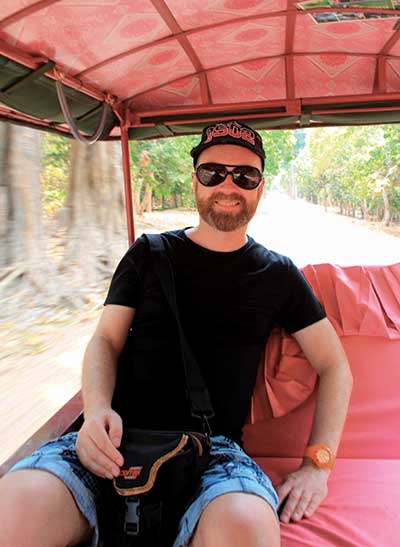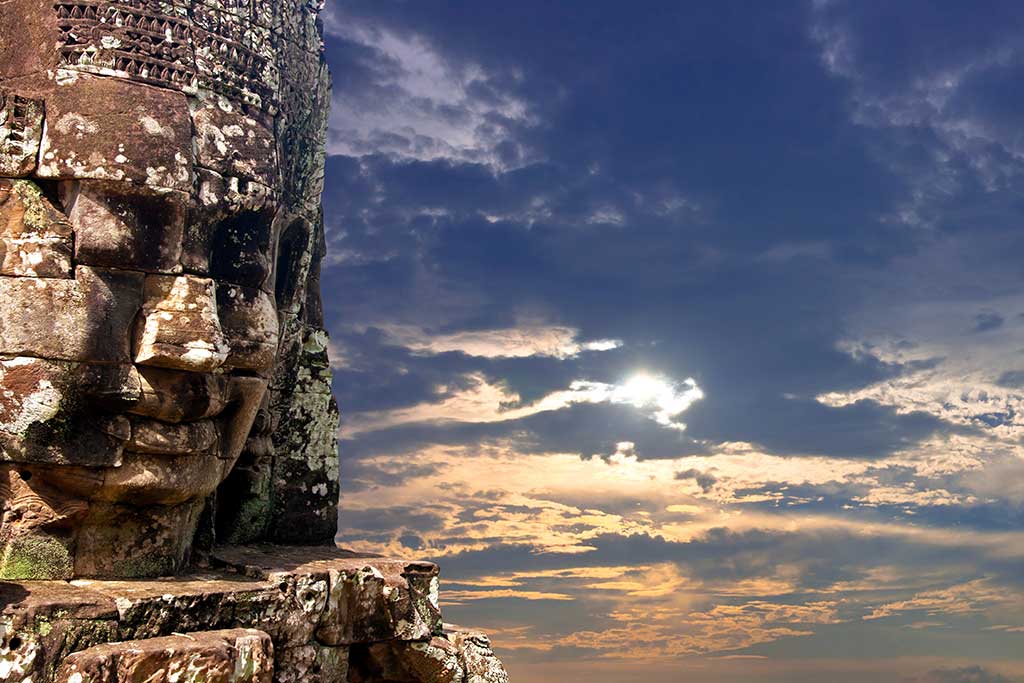Madagascar-born Eric Raisina also struck gold in Siem Reap. Having trained in Paris, working for prestigious fashion houses Yves Saint Laurent and Christian Lacroix, he became smitten after a trip to Angkor’s temples in 1996. Moving here in 2001, he began by working on a silk farm to hone his knowledge of Cambodian silk, including the fine and rare golden silk. Experimenting with methods of production and weaving, he created innovative and tactile silks including his signature crochet-like ‘raffia’ silk and downy soft silk ‘fur.’ These innovations led him to open Eric Raisina Haute Texture, an atelier and couture house on the road between Siem Reap and Angkor.
With a range that extends from silk purses and scarves to bespoke wedding gowns (as well as a select menswear range), in fashion circles his atelier has become a destination as legendary as the temples them- selves. A tall and suave figure, you may also spot him on the gay scene in Siem Reap or Phnom Penh.
Nocturnal activities for most visitors are focused on and around Pub Street, a lively hub of bars and restaurants in Siem Reap’s colorful Old French Quarter. The adjacent alleyways are home to a handful of gay venues.

Ta Prohm Temple in Angkor
Hailing from the United States, Martin Dishman established Siem Reap’s original gay venue Linga Bar in 2004; its name a cheeky reference to a Sanskrit term for phallus. This pioneering gay bar was honored by a visit from pop superstar Ricky Martin in 2008, two years before he openly declared his homosexuality. It was also home to Siem Reap’s first ladyboy revue. In 2014, due to a lease non-renewal, Linga relocated to the lobby of nearby Hotel Be, a bijou three-room hotel that Martin also owns. Furnished with eclectic midcentury pieces, it remains a popular albeit smaller spot. Should you hanker for a ladyboy performance, nearby The Station Wine Bar has regular cabaret shows, which some locals teasingly describe as ‘farmers in frocks.’
New Zealander Dean Williams opened Miss Wong in 2008. Named after a portrait of a beautiful Chinese girl by cult 1950’s artist Vladimir Tretchikoff, this cherry-red re-imagining of vintage Shanghai is a favorite choice for sophisticated cocktails. New to the scene is Barcode Siem Reap, a fun and swish choice opened by Frenchman Pascal Delais.
One drawback of these venues is that they predominantly cater to foreign tourists. Although prices may seem low for Americans and Europeans, they’re expensive for young Cambodians. Some gay locals told me they favor popular straight venues such as Temple Bar on Pub Street, where a draft Angkor beer can be as little as 50¢.
Beyond the gay scene (although with distinct gay appeal), one evening diversion I’d highly recommend is Phare, The Cambodian Circus. Rather than a big top of performing animals, Phare focuses on the physical prowess of its predominantly male troupe, fused with elements of theatre, music, comedy, and dance. Although pleasing on the eye, each show is much more that acrobatic eye-candy: the narrative is often dark and poignant, tackling everything from Cambodia’s brutal history to gay rights and tolerance.
To appreciate the significance of the storytelling, it’s worth knowing that the performers are graduates of the Phare Ponleu Selpak Circus School in Battambang, northwest Cambodia. The school was founded in 1994 by nine young men who’d benefited from art therapy courses at a refugee camp following the fall of the Khmer Rouge, a regime that abolished all forms of art and culture, and murdered vast segments of the population including artists. Returning home, these young men wanted to share what they’d learned with the disenchanted youth of war-ravaged Battambang. What started as drawing classes has evolved into a school with more than 1,200 pupils studying a host of subjects.


Miss Wong
With the school flourishing in Battambang, in 2013 they decided to pitch a circus tent in Siem Reap, raising funds via ticket sales to help the school become self-sustainable. To further secure the school’s future, in January 2016 Phare moved into a new permanent home on the outskirts of Siem Reap. The extended space provides an onsite café for enjoying a pre-show dinner, as well as a boutique selling artworks and gift items made by students.
The evolving creative scene is also evident in Kandal Village, a community of quirky independent shops in the heart of old Siem Reap. Recommendations include Louise Loubatieres, a lifestyle store with pretty handcrafted pieces including lacquered coconut-shell bowls and silk pillows trimmed with antique Cambodian ikats. Much of the stock is designed by its owner, who studied textiles and fashion in London. For something more alternative, try trunkh, whose eclectic mix of art, fashion, one-off vintage pieces, and up-cycled objects were found by American owner Doug Gordon on provincial roadtrips across Cambodia. Afterward, visit The Little Red Fox Espresso, considered the best caffeine fix in town.
Siem Reap’s Old Market and Night Market are popular with bargain hunters, but for guaranteed provenance and quality, head for the pop-up Made in Cambodia Market. Held alongside the Shinta Mani Resort, this community market and street fair focuses on Cambodian-made artisanal products including vibrant lacquered elephants and Krama scarves, a traditional chequered scarf. Foodies should also bulk-buy Kampot Pepper, the Champagne of peppercorns renowned for its aroma and intense flavor.


Tuk-tuk to Angkor
Shopping here can also support worthy causes. Founded in Cambodia in 1994, Friends International works with marginalized urban children and youth across the world. This social enterprise produce gifts such as bags and jewelry made from recycled newspapers, food packaging, and worn car tires, which are sold via their Friends ‘N’ Stuff shops. They also operate restaurants including Marum in Siem Reap (plus an excellent Friends café and shop in the capital, Phnom Penh), providing young locals with training and employment opportunities. Similar socially focused enterprises can be found throughout Cambodia.
The region’s main attraction remains the Angkor UNESCO World Heritage Site to the north of Siem Reap, which receives over two million foreign tourists annually. Visiting these incredible ruins is a breeze. Some may prefer exploring Angkor from the comfort of an air-conditioned car, but it’s most exciting by tuk-tuk.
If you don’t want to take pot-luck by hailing one on the street, hotels can organize a tuk-tuk for you, and some enterprising young drivers even offer temple tours via Grindr! To hire a tuk-tuk and driver for a temples tour costs around $15 for the ‘Small Circuit’ to around $25 for the ‘Grand Circuit.’ Additional charges apply should you wish to commence before dawn to see the sunrise, or visit remote temples such as Banteay Srei.
Before passing through the gate into the Angkor Archaeological Park you must have a ticket. From February 2017, a one-day temple pass costs $37 per person (almost double the previous price), but a portion will be donated to Swiss-run Kantha Bopha Foundation whose five children’s hospitals provide free medical treatment to 500,000 Cambodian children per year, so those extra tourist dollars will be put to good use.
First time visitors can simply stick to what’s known as the ‘Small Circuit’ which covers the core sites including the breathtaking Angkor Wat temple complex, and the great city of Angkor Thom with land- marks including the Terrace of Elephants, Terrace of the Leper King, the pyramid-shaped Phimeanakas palace, and Bayon with its haunting multi-faced carvings of an enigmatic god king.
Your tuk-tuk driver will simply deposit you at each entrance, leaving you free to explore at will, safe in the knowledge that he’ll be waiting at a designated pick-up point to take you to the next amazing site. Licensed tour guides can also be requested, and there are numerous options within the park when it’s time for lunch.
Those wanting a second day of adventure may take the ‘Grand Circuit,’ visiting some outlying sites and temples including the atmospheric Ta Prohm. French archaeologists purposely chose to limit restoration work here. Much of it therefore remains clawed by the roots of giant banyan trees, just as it was when first discovered by 19th-century explorers. Its wild, unruly nature made Ta Prohm the perfect location for Lara Croft: Tomb Raider, so practice your best action-hero stance for that selfie.
I should highlight that visitors are required to wear appropriate attire when visiting temples. Following a recent spate of nude selfies, including three young Frenchmen who were arrested for posing naked at Banteay Kdei Temple in 2015, a strict new dress code introduced in August 2016 compels visitors to cover their knees and shoulders. Remember that Angkor Wat is the world’s largest religious monument, and wearing revealing clothes disrespects the site’s sanctity, hence Lara Croft’s super-short hotpants and tanktop would be outlawed today.


